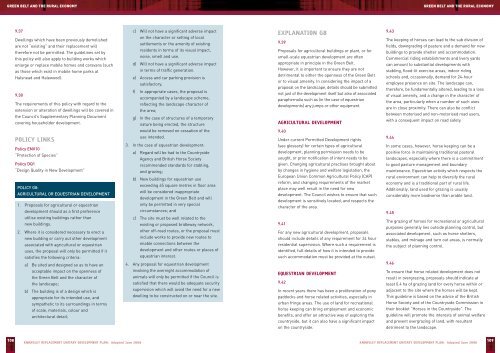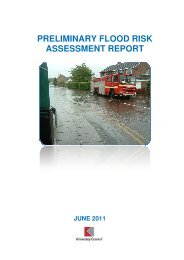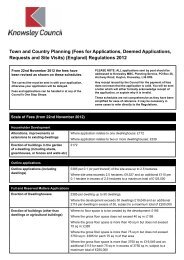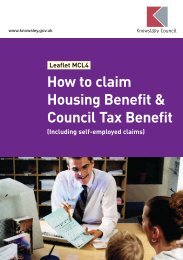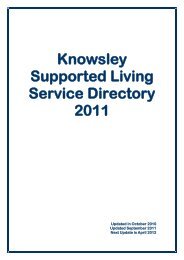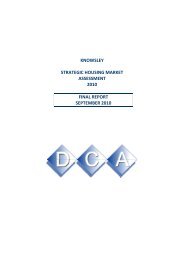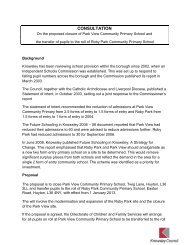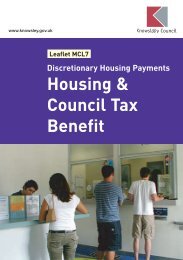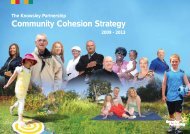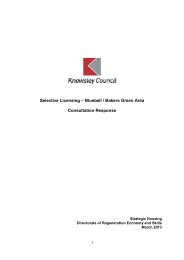Knowsley Replacement Unitary Development Plan - Knowsley Council
Knowsley Replacement Unitary Development Plan - Knowsley Council
Knowsley Replacement Unitary Development Plan - Knowsley Council
You also want an ePaper? Increase the reach of your titles
YUMPU automatically turns print PDFs into web optimized ePapers that Google loves.
GREEN BELT AND THE RURAL ECONOMY<br />
GREEN BELT AND THE RURAL ECONOMY<br />
9.37<br />
Dwellings which have been previously demolished<br />
are not “existing” and their replacement will<br />
therefore not be permitted. The guidelines set by<br />
this policy will also apply to building works which<br />
enlarge or replace mobile homes and caravans (such<br />
as those which exist in mobile home parks at<br />
Halsnead and Halewood).<br />
9.38<br />
The requirements of this policy with regard to the<br />
extension or alteration of dwellings will be covered in<br />
the <strong>Council</strong>'s Supplementary <strong>Plan</strong>ning Document<br />
covering householder development.<br />
POLICY LINKS<br />
Policy ENV10<br />
“Protection of Species”<br />
Policy DQ1<br />
“Design Quality in New <strong>Development</strong>”<br />
POLICY G8:<br />
AGRICULTURAL OR EQUESTRIAN DEVELOPMENT<br />
1. Proposals for agricultural or equestrian<br />
development should as a first preference<br />
utilise existing buildings rather than<br />
new buildings.<br />
2. Where it is considered necessary to erect a<br />
new building or carry out other development<br />
associated with agricultural or equestrian<br />
uses, the proposal will only be permitted if it<br />
satisfies the following criteria:<br />
a) Be sited and designed so as to have an<br />
acceptable impact on the openness of<br />
the Green Belt and the character of<br />
the landscape;<br />
b) The building is of a design which is<br />
appropriate for its intended use, and<br />
sympathetic to its surroundings in terms<br />
of scale, materials, colour and<br />
architectural detail;<br />
c) Will not have a significant adverse impact<br />
on the character or setting of local<br />
settlements or the amenity of existing<br />
residents in terms of its visual impact,<br />
noise, smell and use.<br />
d) Will not have a significant adverse impact<br />
in terms of traffic generation.<br />
e) Access and car parking provision is<br />
satisfactory;<br />
f) In appropriate cases, the proposal is<br />
accompanied by a landscape scheme,<br />
reflecting the landscape character of<br />
the area;<br />
g) In the case of structures of a temporary<br />
nature being erected, the structure<br />
would be removed on cessation of the<br />
use intended.<br />
3. In the case of equestrian development:<br />
a) Regard will be had to the Countryside<br />
Agency and British Horse Society<br />
recommended standards for stabling,<br />
and grazing;<br />
b) New buildings for equestrian use<br />
exceeding 65 square metres in floor area<br />
will be considered inappropriate<br />
development in the Green Belt and will<br />
only be permitted in very special<br />
circumstances; and<br />
c) The site must be well related to the<br />
existing or proposed bridleway network,<br />
other off-road routes, or the proposal must<br />
include works to provide new routes to<br />
enable connections between the<br />
development and other routes or places of<br />
equestrian interest.<br />
4. Any proposal for equestrian development<br />
involving the overnight accommodation of<br />
animals will only be permitted if the <strong>Council</strong> is<br />
satisfied that there would be adequate security<br />
supervision which will avoid the need for a new<br />
dwelling to be constructed on or near the site.<br />
EXPLANATION G8<br />
9.39<br />
Proposals for agricultural buildings or plant, or for<br />
small-scale equestrian development are often<br />
appropriate in principle in the Green Belt.<br />
However, it is important to ensure they are not<br />
detrimental to either the openness of the Green Belt<br />
or to visual amenity. In considering the impact of a<br />
proposal on the landscape, details should be submitted<br />
not just of the development itself but also of associated<br />
paraphernalia such as (in the case of equestrian<br />
developments) any jumps or other equipment.<br />
AGRICULTURAL DEVELOPMENT<br />
9.40<br />
Under current Permitted <strong>Development</strong> rights<br />
(see glossary) for certain types of agricultural<br />
development, planning permission needs to be<br />
sought, or prior notification of intent needs to be<br />
given. Changing agricultural practises brought about<br />
by changes in hygiene and welfare legislation, the<br />
European Union Common Agricultural Policy (CAP)<br />
reform, and changing requirements of the market<br />
place may well result in the need for new<br />
development. The <strong>Council</strong> wishes to ensure that such<br />
development is sensitively located, and respects the<br />
character of the area.<br />
9.41<br />
For any new agricultural development, proposals<br />
should include details of any requirement for 24 hour<br />
residential supervision. Where such a requirement is<br />
identified, full details of how it is intended to provide<br />
such accommodation must be provided at the outset.<br />
EQUESTRIAN DEVELOPMENT<br />
9.42<br />
In recent years there has been a proliferation of pony<br />
paddocks and horse related activities, especially in<br />
urban fringe areas. The use of land for recreational<br />
horse keeping can bring employment and economic<br />
benefits, and offer an attractive way of exploring the<br />
countryside, but it can also have a significant impact<br />
on the countryside.<br />
9.43<br />
The keeping of horses can lead to the sub division of<br />
fields, downgrading of pasture and a demand for new<br />
buildings to provide shelter and accommodation.<br />
Commercial riding establishments and livery yards<br />
can amount to substantial developments with<br />
stabling, flood-lit exercise areas, indoor riding<br />
schools and, occasionally, demand for 24-hour<br />
employee presence on site. The landscape can,<br />
therefore, be fundamentally altered, leading to a loss<br />
of visual amenity, and a change in the character of<br />
the area, particularly when a number of such uses<br />
are in close proximity. There can also be conflict<br />
between motorised and non-motorised road users,<br />
with a consequent impact on road safety.<br />
9.44<br />
In some cases, however, horse keeping can be a<br />
positive force in maintaining traditional pastoral<br />
landscapes, especially where there is a commitment<br />
to good pasture management and boundary<br />
maintenance. Equestrian activity which respects the<br />
rural environment can help to diversify the rural<br />
economy and is a traditional part of rural life.<br />
Additionally, land used for grazing is usually<br />
considerably more biodiverse than arable land.<br />
9.45<br />
The grazing of horses for recreational or agricultural<br />
purposes generally lies outside planning control, but<br />
associated development, such as horse shelters,<br />
stables, and ménage and turn out areas, is normally<br />
the subject of planning control.<br />
9.46<br />
To ensure that horse related development does not<br />
result in overgrazing, proposals should indicate at<br />
least 0.4 ha of grazing land for every horse within or<br />
adjacent to the site where the horses will be kept.<br />
This guideline is based on the advice of the British<br />
Horse Society and of the Countryside Commission in<br />
their booklet “Horses in the Countryside”. The<br />
guideline will promote the interests of animal welfare<br />
and prevent overgrazing of land, with resultant<br />
detriment to the landscape.<br />
108<br />
KNOWSLEY REPLACEMENT UNITARY DEVELOPMENT PLAN: Adopted June 2006<br />
KNOWSLEY REPLACEMENT UNITARY DEVELOPMENT PLAN: Adopted June 2006<br />
109


